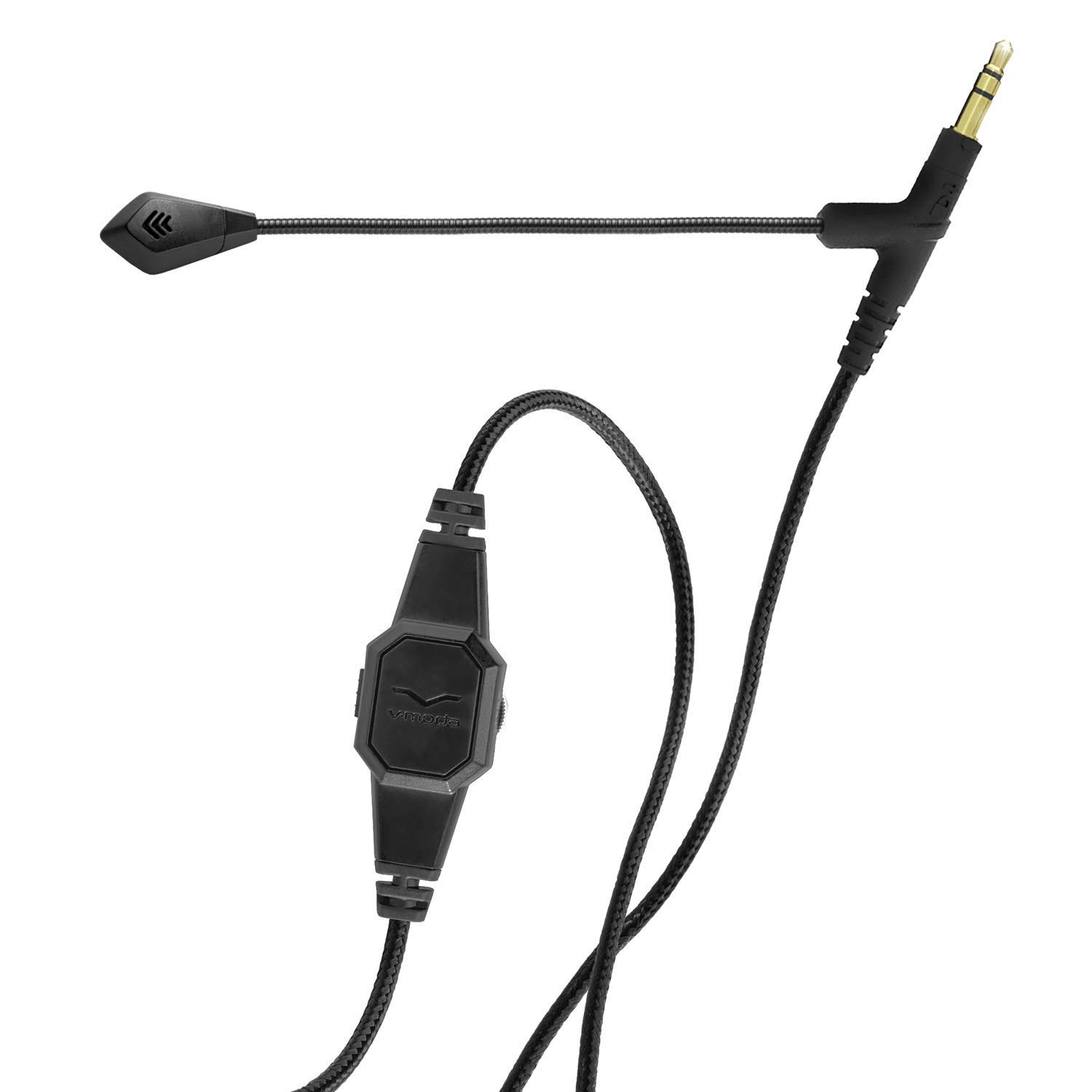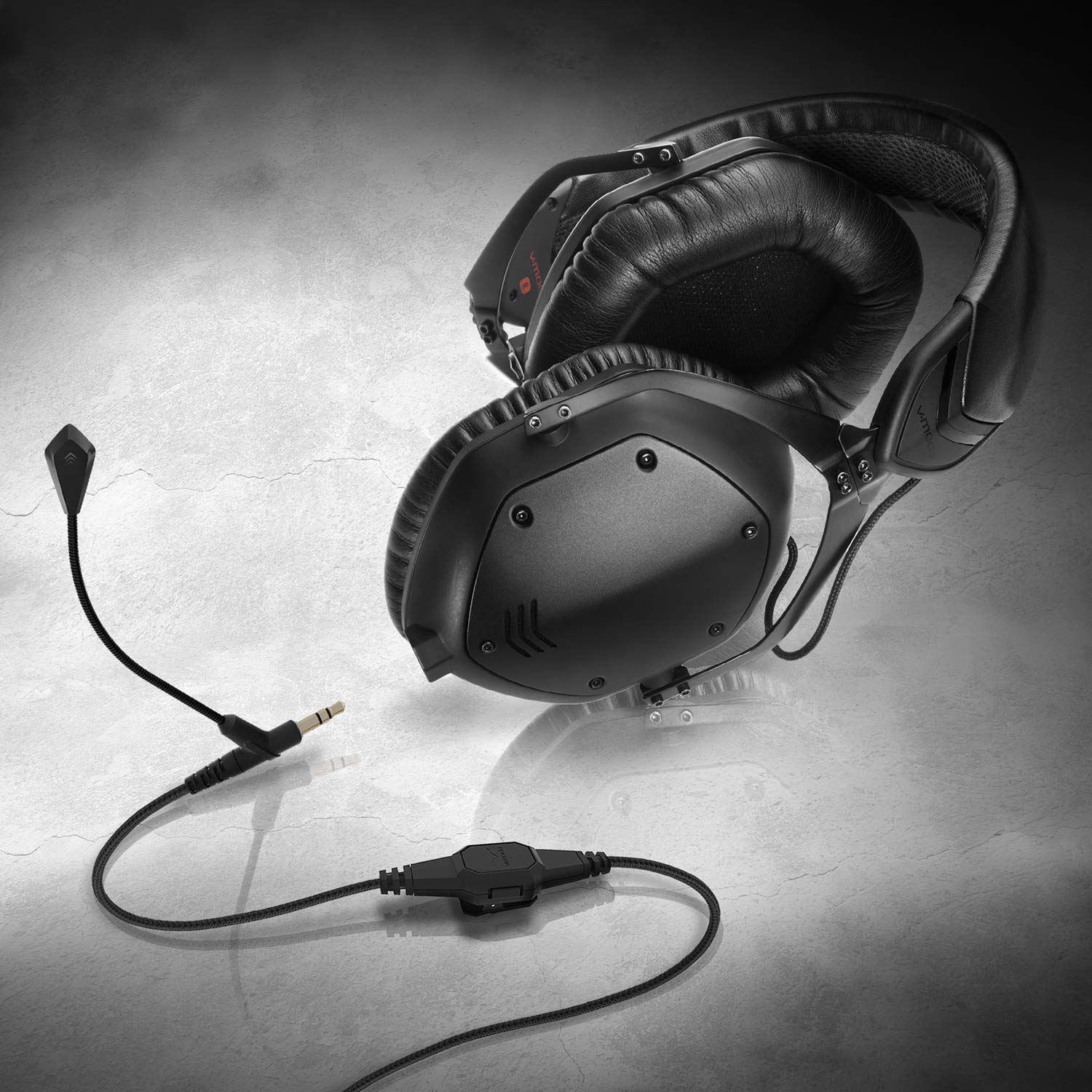
The ≈US$30 V-MODA BoomPro microphone sounds great in its niche and is most similar to another head microphone I have reviewed before, the competing ModMic 5. What they have in common is that they both are designed to attach to your current favorite over-the-ear headphones, which are not included with either microphone. What distinguishes these two mics is the way they attach to your “cans”, which —in the case of the V-MODA— restricts the potential headphone candidates drastically. While the ModMic 5 attaches to practically any over-the-ear headphone using a self-adhesive magnet system, the V-MODA BoomPro ingeniously snaps onto any of the few over-the-ear headphones which have a removable 3.5 mm TRS cable. This greatly simplifies the overall cabling system while making a non-invasive attachment. Let’s explore how the connectivity works, power requirement and listen to a test recording, three ways.

The headphones shown above are not included with the BoomPro.
Standard cabling and connection options
As I explained in the introductory paragraph, the ≈US$30 V-Moda BoomPro (Amazon link — B&H link) completely replaces the factory-supplied cable that came with your favorite over-the-ear headphones, as long as it’s removable. The BoomPro’s own cable is now in charge of everything, including the headphones and the microphone, which is neater than the competing ModMic 5 solution, despite the included accessories to minimize the cable bulk. That’s why the BoomPro’s cable terminates in a TRRS. With that TRRS plug, it will work directly with those smartphones and tablets that still include an analog connection, as well as many laptops. (See my 2015 article TS/TRS/TRRS/TRRRS: Combating the misconnection epidemic.)
The BoomPro also includes an adapter to separate the combined TRRS plug into discreet TRS for the stereo headphones and mono microphone, which is delivered as a two-channel signal for compatibility with most stereo inputs.
I attached the BoomPro to my current favorite over-the-ear, brandable headphones, the US$69 CB-1 from Status Audio (Amazon link) which I reviewed in January 2018, and I really love the combination.
If you need a much lower-cost headphone with removable 3.5 mm to use the BoomPro, consider the “renewed” Corsair HS50 (shown above) for about US$25 (Amazon link). This headphone actually includes a removable microphone, where the microphone is rated poorly, and the headphone is highly rated. If I recall correctly, I actually discovered the Corsair HS50 from a happy user of the BoomPro. The idea is to purchase the Corsair HS50, remove the poor microphone and install the much higher quality BoomPro in its place. I have never tested the Corsair HS50 so far.
Power requirement
The BoomPro mic is an electret condenser and requires bias voltage (aka “plugin power”) which is 3-5 volts and is supplied by most non-balanced mic inputs nowadays.
It’s also supplied by the RØDE SC6-L interface for Apple devices with digital Lightning inputs (iPhone, iPad, iPod Touch), which I have covered in many articles. If you want to connect the BoomPro to one of the mic inputs on the SC6-L, you’ll actually need the adapter to separate microphone and headphone signals (included with the BoomPro), plug the headphone TRS into the middle (headphone) connection on the SC6-L. Then you’ll need another adapter to go from the TRS microphone side of the first adapter to TRRS again, since that the only type of plug accepted by the SC6-L’s microphone inputs.
How to use the BoomPro with an XLR balanced input which only supplies phantom power
Thanks to Francisco Javier Arbolí for modeling for this photo.
If you want to connect the BoomPro (with its included adapter from TRRS to individual TRS for microphone and headphone) to an XLR balanced input, you’ll need an active converter like the RØDE VXLR+ with belt clip (shown above, Amazon — B&H, reviewed here) or the Antlion Audio XLR Power Converter (shown below, Amazon — B&H, reviewed here).
Both of these convert high-voltage 48 volts to low voltage 3-5 volts and adapt the impedance. The RØDE VXLR+ is flat, while the Antlion Audio XLR Power Converter cuts low frequencies.
Polar pickup pattern
Like most lavalier microphones, the BoomPro has an omnidirectional pickup pattern. However, its extreme proximity to the sound source (very close to the mouth of the person speaking), the acoustic signal-to-noise ratio is high. Nonetheless, even a head-mounted omnidirectional head-mounted microphone will still pickup more of the room sound than a cardioid head mounted microphone.
Test recording
I made the test recording by connecting the BoomPro microphone into a single channel of the RØDE SC6-L interface connected to an iPhone SE, using the adapters indicated earlier in this article. I removed the blank track produced by the RØDE Recorder app using Hindenburg Journalist Pro, my favorite multitrack audio editor for conventional computers. (I have covered Hindenburg Journalist Pro in several articles.)
Below you will hear three versions of the same recording: one unprocessed (other than normalization), one with noise reduction and one with noise reduction and compression. All three are uncompressed WAV mono. Please listen with wifi or unmetered data.
Above, unprocessed (other than normalization).
Above, with noise reduction and normalization.
Above with noise reduction and mild compression.
Conclusions/potential applications
As long as you have (or are willing to acquire) a suitable headphone with removable 3.5 mm cable, the ≈US$30 V-Moda BoomPro (Amazon link — B&H link) sounds great (in its category and for its price) and is very flexible in terms of connection options, as detailed in the article. Although I would not recommend using the V-MODA as a main microphone in a studio, I would indeed consider it in the following audio-only or audio-with-video applications:
- For a field interviewer to record her/his voice on an independent track, while s/he monitors the sound using the attached isolating headphones. The interviewee would be recorded with a separate, directional microphone (cardioid or more) on her/his independent track. The only time I would combine the two signals would be for a live broadcast.
- To supply to remote guests together with one of the compatible headphones mentioned earlier, especially when it is too much to expect the remote guest to set up a microphone, clip, stand and isolating headphones and to stay “on mic” (with proper mic placement) during a broadcast, and/or when there is not a budget for the sum of a mic, stand and isolating headphones for remote guests.
Image credit
Many images of the V-MODA BoomPro in this article are courtesy of V-MODA.
Related article
(Re-)Subscribe for upcoming articles, reviews, radio shows, books and seminars/webinars
Stand by for upcoming articles, reviews, and books. Sign up to my free mailing list by clicking here. If you previously subscribed to my bulletins and no longer receive them, you must re-subscribe due to new compliance to GDPR. Most of my current books are at books.AllanTepper.com, and my personal website is AllanTepper.com. Also visit radio.AllanTepper.com.
Si deseas suscribirte (o volver a suscribirte) a mi lista en castellano, visita aquí. Si prefieres, puedes suscribirte a ambas listas (castellano e inglés).
Suscribe to his BeyondPodcasting show at BeyondPodasting.com.
Subscribe to his To boldly split infinitives show at Toboldlysplitinfinitives.com.
Subscribe to his award-winning CapicúaFM show at CapicúaFM.com.
Save US$20 on Google Fi, my favorite mobile telephony and data service
You can use Google Fi for your live broadcasts, using the extra coverage in the US, since it combines three networks in one service: T-Mobile, Sprint and US Cellular. Click here to save US$20 on Google Fi, which now works on iPhone and Android. With Google Fi (covered previously in several articles), there is no extra charge for data-only SIM cards on the same account, for up to 10 devices. You only pay for the total data, and data is free after 6 GB per month. So you could be using one Google FI SIM card on your primary phone, another in a tablet or secondary phone (or third, of fourth…).
FTC disclosure
No manufacturer is specifically paying Allan Tépper or TecnoTur LLC to write this article or the mentioned books. Some of the other manufacturers listed above have contracted Tépper and/or TecnoTur LLC to carry out consulting and/or translations/localizations/transcreations. Many of the manufacturers listed above have sent Allan Tépper review units, although not V-MODA so far. So far, none of the manufacturers listed above is/are sponsors of the TecnoTur , BeyondPodcasting CapicúaFM or TuRadioGlobal programs, although they are welcome to do so, and some are, may be (or may have been) sponsors of ProVideo Coalition magazine. Some links to third parties listed in this article and/or on this web page may indirectly benefit TecnoTur LLC via affiliate programs. Allan Tépper’s opinions are his own. Allan Tépper is not liable for misuse or misunderstanding of information he shares.
Copyright and use of this article
The articles contained in the TecnoTur channel in ProVideo Coalitionmagazine are copyright Allan Tépper/TecnoTur LLC, except where otherwise attributed. Unauthorized use is prohibited without prior approval, except for short quotes which link back to this page, which are encouraged!

